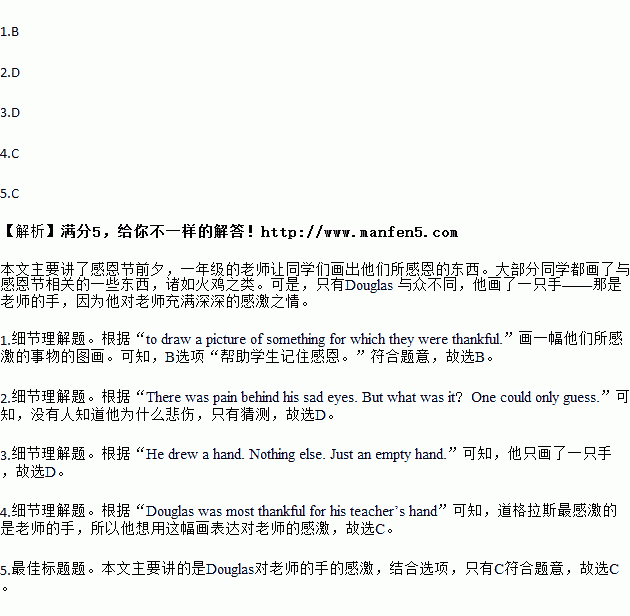题目内容
Thanksgiving Day was near. A first grade teacher gave her class a tun task——to draw a picture of something for which they were thankful.
Most of the students didn’t come from rich families, but many would still celebrate the holiday with turkey and other traditional goodies of season. These, the teacher thought, would be the subjects of most of the students’ art. And they were, for the most part.
But one student named Douglas drew a different kind of picture. Douglas was a different kind of boy. He was often sad. While other children would play with each other during break time, he would stand closely by his teacher’s side. There was pain behind his sad eyes. But what was it? One could only guess.
Yes, his picture was different. He drew a hand. Nothing else. Just an empty hand.
Other children started to guess whose hand it could be. One child guessed it was the hand of a farmer, because farmers raise turkeys. Another suggested a police officer, because police keep people safe. And so the discussion went on.
Finally the teacher walked over to Douglas’ desk, bent down and asked him whose hand it was. The little boy looked away and said, “It’s yours, teacher.”
She recalled the times when she had taken his hand and walked with him here and there. How often had she said “Take my hand, Douglas, we’ll go outside” or “Let me show you how to hold your pencil.”
Douglas was most thankful for his teacher’s hand.
根据材料内容选择最佳答案。
1.Why did the teacher start this task?
A.To see which students were from rich families.
B.To help students remember to be thankful.
C.To find out which students were good at drawing.
D.To show that some traditions are out of date.
2.What do we know about the boy?
A.Nobody wanted to be his friend. B.The teacher didn’t let him play.
C.There were problems with his eyes. D.Nobody knew why he was sad.
3.The boy draw ______.
A.a turkey B.a farmer C.a police officer D.an empty hand
4.The boy tried to ______ with his picture.
A.show that he had a talent for drawing B.show that he liked Thanksgiving
C.express his thanks for his teacher D.help the teacher set up a discussion
5.What is the best tittle of this text?
A.A kind word is like a spring day B.Where there is will, there is a way
C.Teacher’s kind and patient hand D.No attention is paid to those who are always complaining

